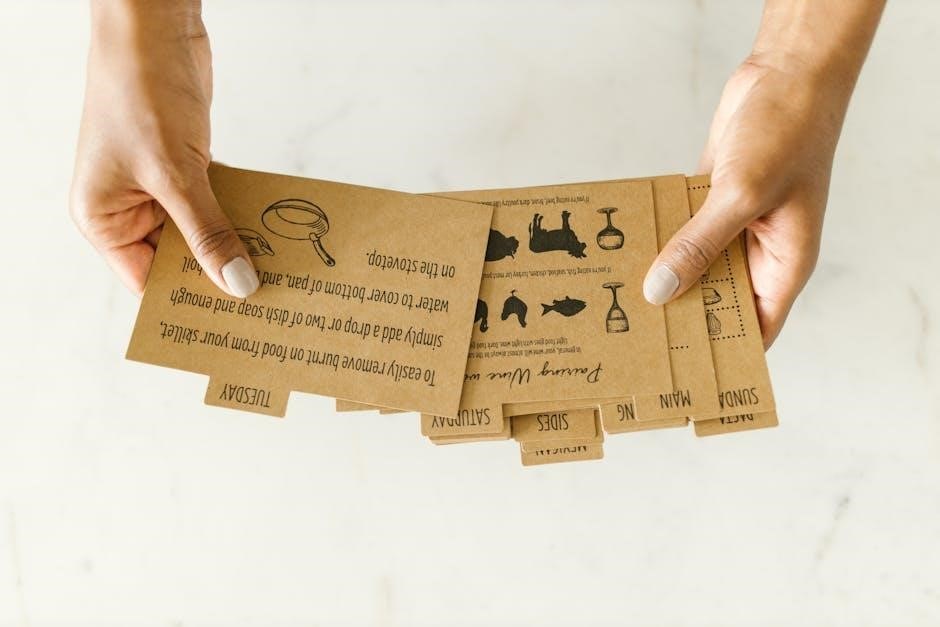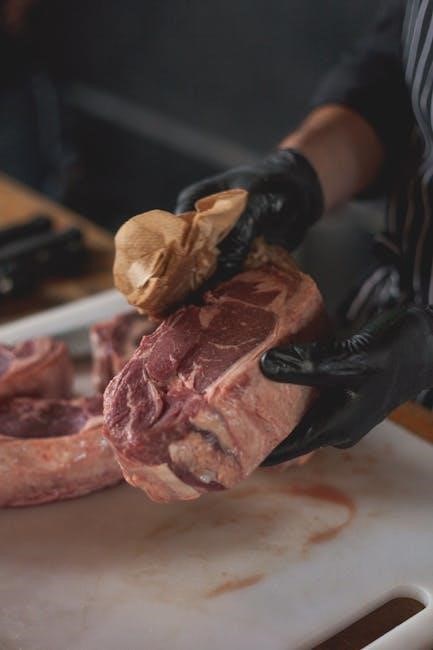
This comprehensive guide explores the art of butchery, covering essential tools, techniques, and best practices. Learn to transform raw ingredients into high-quality, safe, and delicious meat products with precision and skill.

Overview of the Butcher’s Role
A butcher’s role involves skillfully preparing and processing meat, ensuring quality, safety, and presentation. They select, cut, trim, and package meats, using specialized tools and techniques. Butchers must understand animal anatomy, meat grades, and customer preferences to provide precise cuts and recommendations. Their work requires attention to detail, physical stamina, and adherence to hygiene standards. Additionally, butchers often offer expertise in cooking methods and meal planning, making them invaluable in both retail and culinary settings. Their craft bridges the gap between farms and consumers, ensuring sustainable and ethical meat production practices.
Importance of Quality and Safety in Butchery
Maintaining quality and safety is paramount in butchery to ensure consumer health and satisfaction. Proper handling, storage, and processing prevent contamination and spoilage, while adhering to food safety regulations. High-quality meats are sourced from ethical, sustainable practices, ensuring traceability and transparency; Skilled butchers prioritize precision cutting and trimming to enhance flavor and texture, avoiding waste. Cleanliness and sanitation of equipment and workspaces are non-negotiable, safeguarding both products and reputation. Quality and safety form the foundation of trust between butchers and their customers, fostering loyalty and repeat business.
![]()
Essential Tools and Equipment for Butchery
Sharp knives, sturdy cutting boards, and reliable meat grinders are vital for efficient butchery. Scales, sausage stuffers, and vacuum sealers ensure precision and preservation, maintaining quality and safety.
Knives and Sharpening Tools
High-quality knives are the backbone of butchery, with chef’s knives, boning knives, and cleavers being essentials. Sharpening tools like whetstones, sharpening steels, and electric sharpeners maintain blade precision. A sharp knife ensures clean cuts, enhances safety, and preserves meat quality. Regular sharpening prevents dull edges, which can lead to accidents and uneven trimming. Investing in durable knives and proper sharpening techniques is crucial for efficient and professional butchery work, ensuring optimal results in every cut.
Cutting Boards and Work Surfaces
Durable cutting boards and work surfaces are essential for efficient butchery. Wooden, plastic, or stainless steel boards are popular choices, each offering unique benefits. A stable, clean surface ensures precision and safety while processing meat. Regular cleaning and sanitizing are crucial to prevent contamination. Properly maintained work surfaces protect both the meat and the butcher, ensuring a hygienic environment for cutting and trimming. Investing in high-quality materials and practicing good hygiene habits are fundamental to professional butchery practices and food safety standards.

Meat Grinders and Sausage Stuffers
Meat grinders and sausage stuffers are indispensable tools for processing meat. Grinders ensure uniform texture and consistency, while stuffers help create perfectly filled sausages. Choose grinders with adjustable settings for coarse or fine grinding. Sausage stuffers come in manual or hydraulic models, offering precision control. Regular maintenance, such as cleaning and sharpening grinder blades, is crucial for optimal performance. These tools empower butchers to craft custom sausages and ground meats, enhancing creativity and efficiency in meat preparation while maintaining high-quality results.
Scales and Measuring Tools
Scales and measuring tools are essential for precision in butchery. Digital scales provide accurate weight measurements, ensuring consistent portioning and mixing. Balance scales are ideal for larger quantities, offering durability and reliability. Measuring tools like calipers help gauge meat thickness for uniform cuts. Additionally, portion scoops and measuring cups ensure precise ingredient ratios for sausages and cures. Accurate measurements are critical for maintaining quality, safety, and flavor in butchered products, making these tools indispensable in both professional and home butchery settings.
Understanding Different Cuts of Meat
Mastering meat cuts is fundamental for butchers. From tender steaks to flavorful roasts, each cut offers unique characteristics, ensuring optimal cooking methods and culinary experiences.
Beef Cuts: Chuck, Rib, Loin, and Round
Beef cuts vary in tenderness and flavor. Chuck is ideal for ground beef and stews, while rib offers rich, marbled meat perfect for roasts. The loin provides tender steaks like strip loin, and the round is lean, great for roasts or steaks; Understanding these cuts helps in selecting the right meat for various dishes, ensuring optimal flavor and texture in every preparation.
Pork Cuts: Shoulder, Belly, Loin, and Ham
Pork shoulder is perfect for slow-cooking, offering tender, flavorful meat. The belly is fatty, ideal for bacon or roasting. The loin is lean, great for chops and roasts, while ham is cured and often served whole or sliced. Each cut offers unique textures and tastes, making pork versatile for various dishes, from hearty stews to elegant roasts.
Chicken and Poultry Cuts
Chicken and poultry cuts are versatile and widely used in various cuisines. Whole birds are ideal for roasting, while breasts, thighs, wings, and drumsticks offer convenience. Ground poultry is perfect for patties or meatballs. Boneless, skinless cuts are popular for grilling or sautéing. Understanding these cuts allows for precise portioning and preparation, ensuring tender and flavorful results. Proper handling and storage are key to maintaining quality and safety, making poultry a staple in many kitchens worldwide.
Lamb and Game Meat Cuts
Lamb and game meats offer rich, distinct flavors, with cuts tailored for various cooking methods. Lamb legs, racks, and shanks are ideal for roasting or slow cooking, while ground lamb is perfect for burgers or meatballs. Game meats like venison, elk, and wild boar provide leaner options with robust flavors. Proper handling and portioning are essential to ensure tenderness and quality. Understanding these cuts allows for creative and flavorful dishes, making them a favorite among chefs and home cooks seeking unique culinary experiences.

Basic Butchery Techniques
Mastering fundamental techniques like boning, trimming, and portioning is crucial for efficient meat preparation. These skills form the foundation for creating high-quality cuts and dishes.
Boning and Trimming
Boning and trimming are essential skills in butchery, involving the removal of bones and excess fat to enhance meat quality and presentation. Boning requires precision to avoid wasting valuable meat, while trimming ensures a clean, lean final product. These techniques not only improve the appearance of cuts but also reduce cooking time and enhance flavor. Proper tools, like boning knives, are crucial for efficiency and safety. Mastery of these steps is fundamental for preparing high-quality meats for further processing or direct consumption.
Cutting and Portioning
Cutting and portioning are critical steps in butchery, ensuring consistent and visually appealing meat cuts. Precision is key to maintaining uniformity, whether slicing steaks or dicing meat for stews. Proper knife techniques and understanding muscle structures help achieve clean cuts. Portioning also involves considering the intended use of the meat, such as thickness for grilling or size for even cooking. Accurate measurements and sharp tools are essential for efficiency and quality, making this step a cornerstone of professional butchery practices.
Wrapping and Packaging
Proper wrapping and packaging are essential for maintaining meat quality and freshness. Techniques include vacuum-sealing, shrink-wrapping, and using butcher paper or plastic wrap. These methods prevent oxidation, contamination, and moisture loss. Clear labeling with cut type, weight, and date ensures organization and traceability. Proper packaging also enhances presentation, making products more appealing to consumers. Storing meats in airtight containers or bags at appropriate temperatures further preserves flavor and texture, ensuring a professional finish to the butchery process.
Advanced Butchery Skills
Mastering advanced techniques like sausage making, curing, and creating specialty cuts elevates your craft. These skills require precision, patience, and a deep understanding of meat science and flavor profiling.
Sausage Making and Stuffing
Sausage making is an art that combines precision and creativity. It involves grinding meats, blending spices, and stuffing casings to create flavorful links. Proper equipment, like grinders and stuffers, is essential. Seasoning must be balanced, and casings should be handled carefully to avoid tears. Cooking sausages requires controlled heat to prevent bursting. Tips for beginners include using natural casings and not overstuffing. This technique allows for customization, making it a rewarding skill for any butcher or home enthusiast to master.
Curing and Smoking Meats
Curing and smoking meats are traditional preservation methods that enhance flavor and texture. Curing involves using salt or sugar to draw out moisture, preventing bacterial growth. Smoking adds a rich, savory flavor and acts as a natural preservative. Both processes require precise temperature and humidity control to ensure safety and quality. Proper techniques, like using the right wood for smoking and monitoring meat consistency, are crucial. This method not only preserves meat but also elevates its taste, making it a beloved technique for home cooks and professionals alike.
Creating Specialty Cuts
Creating specialty cuts requires precision and creativity, transforming standard meats into unique, visually appealing products. Butchers craft custom cuts like Japanese Wagyu slices or French poulet rouge, ensuring each piece meets specific culinary demands. Techniques involve meticulous trimming, portioning, and presentation. Specialty cuts often highlight marbling, tenderness, or flavor profiles, making them ideal for gourmet dishes. Proper handling and presentation are key to enhancing their appeal. This skill allows butchers to cater to diverse tastes and preferences, setting their work apart in the culinary world.
Meat Processing and Preservation
Meat processing and preservation involve techniques like curing, smoking, and vacuum packaging to maintain quality, safety, and flavor. These methods prevent spoilage and extend shelf life effectively.
Curing Methods
Curing is a traditional method of preserving meat using salt, sugar, or other ingredients to prevent spoilage and enhance flavor. Dry curing involves coating the meat, while wet curing uses a brine solution. Proper curing ensures food safety by inhibiting bacterial growth. Techniques vary depending on the type of meat and desired outcome. Curing is essential for creating cured meats like bacon, ham, and salami. Always use precise measurements and follow tested recipes to achieve consistent results and maintain quality;
Smoking Techniques
Smoking is a versatile method for preserving and flavoring meats. Hot smoking cooks meat while infusing smoky flavor, typically at 100°F to 250°F. Cold smoking preserves meat at lower temperatures, below 100°F, without cooking. Choose wood types like hickory, apple, or cherry for distinct flavors. Proper ventilation and temperature control are crucial for safety and quality; Smoking enhances texture and aroma, creating delicious results for sausages, bacon, and other meats. Always follow tested recipes and safety guidelines to achieve optimal outcomes.
Vacuum Packaging and Freezing
Vacuum packaging removes air to prevent oxidation and contamination, preserving meat freshness. Freezing slows bacterial growth, maintaining quality and flavor. Use freezer-safe materials and label packages with dates. Store at 0°F or below for optimal results. This method is ideal for long-term storage of raw or cooked meats, ensuring minimal moisture loss and extended shelf life. Proper sealing and storage techniques are essential for maintaining texture and preventing freezer burn. Always follow safe handling practices to ensure meat remains safe and flavorful.
Cooking Methods for Butcher-Cut Meats
Explore various cooking methods for butcher-cut meats, including grilling, pan-searing, roasting, slow cooking, and braising. Each technique enhances flavor and texture, ensuring a perfect dish every time.
Grilling and Roasting
Grilling and roasting are popular cooking methods for butcher-cut meats, offering distinct flavors and textures. Grilling involves high heat, creating a caramelized crust, while roasting uses dry heat for even cooking. Both methods enhance natural flavors, especially when paired with seasonings. For grilling, ensure meat is at room temperature and cook over medium-high heat. For roasting, use a roasting pan and maintain consistent oven temperature. Proper resting after cooking ensures juices redistribute, resulting in tender, flavorful dishes. These techniques are ideal for steak, roasts, and poultry, delivering a satisfying culinary experience;
Pan-Sealing and Searing
Pan-sealing and searing are essential techniques for achieving a flavorful crust on butcher-cut meats. Preheat a skillet over high heat, add oil, and sear meat until browned. This method locks in juices and enhances texture. Use cuts like steak or chops for best results. Deglaze the pan with liquid for a rich sauce. Proper searing requires even heat and minimal movement. These techniques are versatile for various meats and ensure a professional finish, making them a staple in both home and restaurant kitchens.
Slow Cooking and Braising
Slow cooking and braising are ideal for tenderizing tougher cuts of meat, like brisket or shank. These methods involve cooking meat in liquid, such as stock or wine, over low heat for an extended period. The result is tender, flavorful meat with rich, depthful sauces. Browning the meat before slow cooking enhances flavor. This technique is perfect for hearty dishes and ensures even cooking. It’s a versatile method for achieving fall-apart texture and robust flavors, making it a favorite for home cooks and professional butchers alike.
Hygiene and Safety in Butchery
Maintaining strict hygiene and safety protocols is crucial in butchery to prevent contamination and ensure quality. Clean equipment regularly and handle raw meat safely to avoid risks.
Cleaning and Sanitizing Equipment
Cleaning and sanitizing equipment is essential to maintain hygiene in butchery. Wash tools with soap and warm water, rinse thoroughly, and sanitize using a food-safe solution. Regularly deep clean surfaces and machinery to remove residue. Dry equipment after cleaning to prevent rust and bacterial growth. Sanitize all utensils after each use and at the end of the day to ensure a clean workspace. This prevents contamination and maintains the quality of meat products, ensuring safety for consumption.
Proper Handling of Raw Meat
Proper handling of raw meat is crucial to prevent contamination and ensure safety. Always use separate cutting boards and tools for raw and cooked meats to avoid cross-contamination. Store raw meat at the correct refrigerated temperature below 40°F (4°C) to slow bacterial growth. Handle meat gently to avoid tearing, which can lead to spoilage. Use food-safe wraps or containers to prevent exposure to air and contaminants. Regularly inspect meat for signs of spoilage, such as discoloration or unpleasant odors, and discard if necessary. Maintain personal hygiene by washing hands thoroughly before and after handling raw meat.

Food Safety Regulations
Food safety regulations are essential for maintaining high standards in butchery. These guidelines ensure that meat products are safe for consumption by preventing contamination and promoting proper handling practices. Key regulations include strict temperature controls, proper labeling, and adherence to hygiene standards. Butchers must comply with local and national food safety laws, such as HACCP (Hazard Analysis Critical Control Point) systems, to minimize risks of foodborne illnesses. Regular inspections and certifications are often required to ensure compliance, protecting both consumers and the business.


Ethical and Sustainable Butchery Practices
Ethical butchery emphasizes sourcing animals raised with care and minimizing environmental impact. Sustainable practices include reducing waste and supporting local farmers to promote eco-friendly meat production methods.
Sourcing Ethically Raised Animals
Sourcing ethically raised animals ensures humane treatment, better welfare, and sustainable farming practices. Look for farms that prioritize organic feed, free-range conditions, and minimal environmental impact. Building relationships with local farmers fosters transparency and trust, guaranteeing the quality and origin of the meat. Ethical sourcing promotes fair labor practices and supports local economies, contributing to a more sustainable food system. This approach not only benefits the animals but also results in higher-quality, more flavorful meat for consumers.
Reducing Waste in Butchery

Reducing waste in butchery involves utilizing every part of the animal to minimize discard. Organs, bones, and trimmings can be transformed into broth, stock, or ground meat. Proper portioning and trimming ensure minimal scraps. Using scraps for sausages or pâté maximizes efficiency. Storing leftovers correctly prevents spoilage, further reducing waste. Ethical butchery practices emphasize sustainability, ensuring resources are used responsibly. By adopting these methods, butchers contribute to environmental conservation while maintaining profitability and respecting the animal’s value.
Supporting Local Farmers
Supporting local farmers is crucial for sustainable butchery, ensuring fresh, high-quality meat while boosting the local economy. Building relationships with nearby farms fosters trust and transparency, allowing butchers to source ethically raised animals. This collaboration promotes environmentally friendly practices, reduces carbon footprints from transportation, and preserves regional livestock diversity. By prioritizing local suppliers, butchers contribute to community resilience and offer customers superior, traceable products. This partnership also encourages innovation, as local farmers and butchers can develop unique, artisanal meats together, benefiting both businesses and consumers alike.
Troubleshooting Common Butchery Issues
Addressing challenges like tough meat, overcooking, and fat distribution is essential for perfect results. This section offers practical solutions to refine your butchery skills effectively.
Dealing with Tough or Chewy Meat
Tough or chewy meat can result from improper cutting, overcooking, or poor quality. To address this, use tenderizing techniques like marinating, slow cooking, or pounding. Ensuring proper knife angles and avoiding overworking the meat during preparation can also help. Additionally, selecting the right cuts for specific cooking methods is crucial. For instance, tougher cuts like brisket or shank are ideal for slow cooking, which breaks down connective tissues, resulting in tender, flavorful dishes. Proper handling and cooking techniques can transform tough meat into a delicious meal.
Fixing Overcooked or Undercooked Meats
Overcooked meats can be salvaged by slicing thinly against the grain or shredding for dishes like stews or sandwiches. For undercooked meats, finish cooking in a pan with liquid or sear quickly to avoid drying out. Always use a thermometer to ensure safe internal temperatures. Proper handling and cooking techniques prevent these issues, ensuring juicy, flavorful results every time. Adjusting cooking methods and monitoring doneness are key to achieving perfectly cooked meats.

Addressing Fat and Marbling Issues
Fat and marbling are crucial for flavor and texture in meats. Excessive fat can be trimmed using a sharp boning knife, ensuring even distribution. For lean meats, adding fat during cooking enhances juiciness. Proper trimming techniques prevent waste while maintaining quality. Balancing fat content is key to achieving tender, flavorful results. Always use precision tools to avoid over-trimming, as this can compromise the meat’s natural characteristics. Addressing fat issues requires skill and attention to detail to preserve the meat’s integrity and culinary value.
Mastering butchery requires patience, practice, and dedication. Stay curious, experiment with new techniques, and always prioritize quality and safety. Happy cutting and cooking!
Mastery of butchery begins with tool proficiency, understanding meat anatomy, and precise cutting techniques. Essential skills include boning, trimming, and portioning meats accurately. Safety and efficiency are paramount, ensuring clean cuts and minimal waste. Developing a keen sense of texture and marbling enhances product quality. Continuous learning and adaptation to new methods are crucial for refining expertise. By combining tradition with innovation, butchers can create exceptional, customized cuts that meet diverse culinary needs while maintaining high standards of quality and safety.
Encouragement for Continuous Learning
Continuous learning is vital in mastering butchery, as techniques evolve and new methods emerge. Stay curious and open to exploring innovative practices, from advanced cutting techniques to sustainable practices. Experiment with different tools and ingredients to refine your skills. Engage with workshops, online courses, and professional communities to gain insights and inspiration. Embrace challenges as opportunities to grow, ensuring your craft remains dynamic and adaptable. By committing to lifelong learning, you’ll stay at the forefront of the butchery trade and deliver exceptional results consistently.
Resources for Further Education
Expand your butchery knowledge through reputable resources like online courses, workshops, and professional certifications. Websites such as Coursera and Udemy offer specialized programs. Professional organizations like the American Meat Science Association provide workshops and certifications. Books by expert butchers, such as The Butcher’s Apprentice, offer in-depth guidance. Join online forums and communities to connect with professionals and gain practical insights. Attend industry events and seminars to stay updated on trends and techniques. Continuous education ensures mastery and adaptability in the ever-evolving field of butchery.